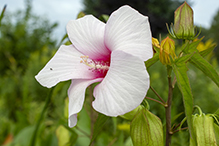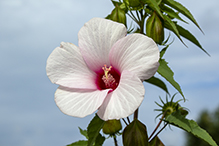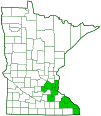halberd-leaf rosemallow
(Hibiscus laevis)
Conservation • Wetland • Description • Habitat • Ecology • Use • Distribution • Taxonomy
Description |
Halberd-leaf rosemallow is a large, showy, herbaceous, flowering plant. It occurs in the United States from New Jersey to northern Florida, west to South Dakota and eastern Texas. It is uncommon in Minnesota. It is found in marshes and swamps; in low areas along rivers and streams; on islands in rivers, streams, and ponds; and in roadside ditches. It grows under full or partial sun in wet fertile soil. It frequently forms large colonies. Halberd-leaf rosemallow is a 2½′ to 6½′ (80 to 200 cm) tall, erect, perennial herb that rises on a single stem from a taproot. The stem is erect or ascending and round. It may be unbranched or sparingly branched, and it may be hairless or almost hairless. It is often somewhat covered with a whitish, waxy film (glaucous), and it is sometimes slightly woody near the base. The leaves are alternate, 2⅜″ to 7″ (6 to 18 cm) long, and 1 3⁄16″ to 6¼″ (3 to 16 cm) wide. They are on leaf stalks (petioles) that are half as long as the blade or somewhat longer. The leaf blade is narrowly to broadly egg-shaped in outline. It is heart shaped to straight across (truncate) at the base, and it is narrowed to a point at the tip with concave sides along the tip (acuminate). It is usually arrow-shaped, shallowly to deeply 3-lobed at the base but with the lateral lobes turned outward rather than downward (hastate). The middle lobe is triangular and is much longer than the lateral lobes. The leaf is said to resemble a medieval halberd, and this is the feature that gives the plant part of its common name. Some leaves may have 5 lobes and resemble a maple leaf. Some leaves may be unlobed and lance shaped or egg shaped. The upper and lower surfaces are hairless. The margins are relatively finely sawtoothed (serrate). There is a pair of awl-shaped, leaf-like appendages (stipules) at the base of the blade, but these are shed during the leaf’s development. The inflorescence is solitary flowers in the axils of the upper leaves and occasionally at the end of the stem. Each flower is on a jointed, ⅜″ to 4″ (1 to 40 mm) long stalk (pedicel). Beneath each flower head there are 9 to 15 modified leaves (bracts). The bracts are conspicuous, ⅜″ to 1 3⁄16″ (10 to 30 mm) long, linear, upwardly curved, and hairless. The flowering period in Minnesota is August to September. Each flower lasts just a single day. The flowers are broadly funnel shaped and very large, up to 5″ in diameter. There are 5 outer floral leaves (sepals), 5 petals, numerous stamens, and 5 styles. The sepals are fused at the base into a 1″ to 1⅜″ (25 to 35 mm) long, hairless, narrowly bell-shaped cup (calyx), then separated into 5 broadly triangular lobes. The petals are usually pink, sometimes white, and they usually have a dark reddish-purple base. They are inversely egg shaped, 2″ to 3″ (50 to 80 mm) long, and 1″ to 2″ (25 to 50 mm) wide. The stalks of the stamens (filaments) are fused from the base into a straight, pale pink to white, 1″ to 1½″ (25 to 40 mm) long column. They are separated for just 1⁄16″ to ⅛″ (2 to 4 mm) at the top. The styles are fused for most of their length into an upwardly curved tube, then separated into 5 branches at the tip. Each branch has a globe-shaped or disk-shaped, pale pink to white stigma at the tip. The fruit is a brown, egg shaped, 11⁄16″ to 1 3⁄16″ (18 to 30 mm) long capsule with 60 to 90 seeds. The capsule is completely enveloped in the persistent calyx, which has become about 1 9⁄16″ (40 mm) long. The enveloped fruit is subtended by the persistent, upwardly curved bracts. |
Height |
2 ½′ to 6 ½′ (80 to 200 cm) |
Flower Color |
Pale pink to white |
Similar Species |
Habitat |
Wet. Full or partial sun. Marshes; swamps, roadside ditches, and along rivers, streams, and ponds. |
Ecology |
Flowering |
August to September |
Pests and Diseases |
|
Use |
|
Distribution |
||
|
Sources |
|
| 11/12/2024 | ||
Nativity |
||
Native |
||
Occurrence |
||
Uncommon in Minnesota |
||
Taxonomy |
|
Kingdom |
|
| Division |
Tracheophyta (Vascular Plants) |
Subdivision |
Spermatophytina (Seed Plants) |
Class |
|
Order |
Malvales (mallows, rock-roses, and allies) |
Family |
Malvaceae (mallow and hibiscus) |
Subfamily |
Malvoideae |
Tribe |
Hibisceae |
Genus |
Hibiscus (Hibiscuses) |
Subordinate Taxa |
|
|
|
Synonyms |
|
Hibiscus coccineus var. virginicus Hibiscus hastatus Hibiscus laevis Hibiscus militaris Hibiscus riparius Hibiscus virginicus Sphaeroma ambiguum |
|
Common Names |
|
halberdleaf rosemallow halberd-leaf rose mallow halberd-leaf rosemallow halberd-leaf rose-mallow halberd-leaved rose mallow halberd-leaved rosemallow halberd-leaved rose-mallow military hibiscus rose mallow scarlet rosemallow scarlet rose-mallow smooth rose-mallow sweatingweed sweating-weed |
|
Glossary
Acuminate
Gradually tapering with concave sides to a sharply pointed tip.
Ascending
Growing upward at an angle or curving upward from the base.
Axil
The upper angle where a branch, stem, leaf stalk, or vein diverges.
Bract
Modified leaf at the base of a flower stalk, flower cluster, or inflorescence.
Calyx
The group of outer floral leaves (sepals) below the petals, occasionally forming a tube. Plural: calyces.
Corolla
A collective name for all of the petals of a flower.
Filament
On plants: The thread-like stalk of a stamen which supports the anther. On Lepidoptera: One of a pair of long, thin, fleshy extensions extending from the thorax, and sometimes also from the abdomen, of a caterpillar.
Glaucous
Pale green or bluish gray due to a whitish, powdery or waxy film, as on a plum or a grape.
Linear
Long, straight, and narrow, with more or less parallel sides, like a blade of grass.
Pedicel
On plants: the stalk of a single flower in a cluster of flowers. On insects: the second segment of the antennae. On Hymenoptera and Araneae: the narrow stalk connecting the thorax to the abdomen: the preferred term is petiole.
Petiole
On plants: The stalk of a leaf blade or a compound leaf that attaches it to the stem. On ants and wasps: The constricted first one or two segments of the rear part of the body.
Sepal
An outer floral leaf, usually green but sometimes colored, at the base of a flower.
Stipule
A small, leaf-like, scale-like, glandular, or rarely spiny appendage found at the base of a leaf stalk, usually occurring in pairs and usually dropping soon.
Visitor Photos |
||
Share your photo of this plant. |
||
This button not working for you? |
||
Greg Watson |
||
 |
 |
|
I noticed that you don’t have a listing for the Halberd-leaved Rose Mallow, Hibiscus laevi. The pictures were taken on the trail around Lake Winona, in Winona, MN. |
||
MinnesotaSeasons.com Photos |
||

Slideshows |
|

Visitor Videos |
||
Share your video of this plant. |
||
This button not working for you? |
||
|
Other Videos |
||
|

Visitor Sightings |
||
Report a sighting of this plant. |
||
This button not working for you? |
||
Greg Watson |
Location: Winona, MN I noticed that you don’t have a listing for the Halberd-leaved Rose Mallow, Hibiscus laevi. The pictures were taken on the trail around Lake Winona, in Winona, MN. |
 |
MinnesotaSeasons.com Sightings |
||
|

|
Created: 11/12/2024 Last Updated: © MinnesotaSeasons.com. All rights reserved. |
